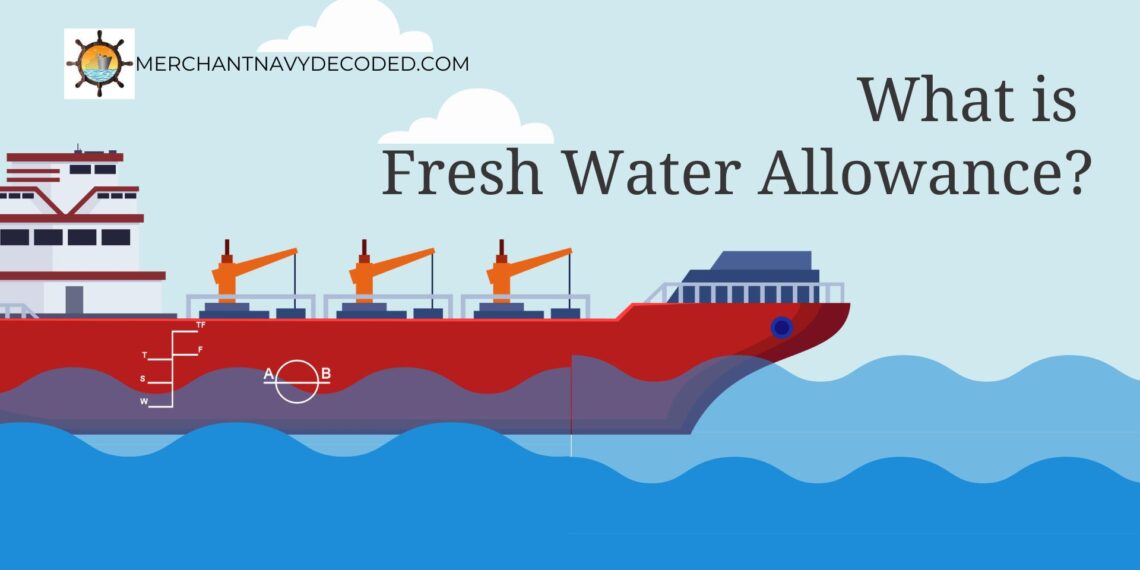What is Fresh Water Allowance?
Overview
When a ship moves from saltwater to freshwater, it feels heavier and sinks deeper into the water, increasing its draft (how much of the ship is underwater). When the ship moves from freshwater back to saltwater, the ship feels lighter and rises higher in the water, so its draft decreases because less of the ship is underwater. This phenomenon happens because of a change in the density of water.

1:- What is FWA?
When a ship goes from salt water to fresh water, it will sink further in FW. This will increase the draft of the vessel in FW. FWA is the millimeter by which the mean draft increases when the ship passes from SW to FW and vice-versa when the ship is loaded to summer displacement.
1.1:- Fresh Water Allowance Formula
FWA(mm) = W/(4*TPC)
Or
FWA(cm) = W/(40*TPC)
Where, W : Is the displacement of the ship in salt water, expressed in tonnes.
TPC: Is the tonnes per centimeter immersion in salt water.
FWA: Is the fresh water allowance in centimeters or millimeters
The FWA of a ship usually increases as the draft increases. The reason for this is that the submerged volume influences W, while the area at the waterline determines TPC. When the ship sinks deeper into the water, both W and TPC rise, but W climbs more rapidly. Therefore, the FWA, derived from the above equation, likewise escalates with an increase in the draft.
The FWA for summer load, calculated from the given formula, is the ship’s FWA. It’s listed on the load line certificate and stays the same for the load marks – T, S, W, and WNA – on the ship.
When a ship is loading down to her marks in FW, she can immerse her load line by the FWA of the ship so that when she goes to SW, she would rise to her appropriate load line
2:- What is DWA?
Dock water density is the density of water between the two limits i.e., it is more than the density of freshwater ( 1.000 t/m^3) and less than that of salt water ( 1.025 t/m^3).
“Dock water allowance” refers to the adjustment made to the draft (the depth of a ship’s hull below the waterline) when a ship is in port and moored at a dock. This adjustment accounts for the difference in water density between the ship’s previous location and the water at the dock.

2.1:- Dock Water Allowance Formula
DWA = Change in densities * FWA
Where,
- FWA: Fresh water allowance
- DWA: Dock water allowance
When a ship moves from one body of water to another, such as from seawater to freshwater or vice versa, the density of the water changes, affecting the ship’s buoyancy and draft. Dock water allowance ensures that the ship maintains a safe and appropriate draft while moored at the dock.
On the other hand, if a ship goes from freshwater to seawater, it floats lower because seawater is less buoyant. To keep enough space below and stay stable, the ship might need to be allowed to sink a bit more.
3:- Conclusion
In conclusion, freshwater allowance is significant for keeping ships safe when they move from the SW to FW. It stops the ship from submerging too deep and hitting the bottom or tipping over. So, it’s a big help for making sure ships can travel smoothly and safely, no matter the type of water they’re in.
There is one more thing that helps to keep the safety of the ship in check which is draft marks, so if you are interested in learning the concept of draft marks: CLICK HERE.
4:- Fresh Water Allowance Frequently Asked Questions
1. What is the freshwater allowance formula?
FWA = W/(4 x TPC) where FWA you will get in centimeters.
2. What are FWA and DWA?
FWA is the millimeter by which the mean draft increases when the ship passes from SW to FW and vice-versa.
DWA refers to the amount of millimeters by which a draft of the ship changes when going from SW to DW and vice-versa.
3. What is the importance of freshwater allowance?
Freshwater allowance is crucial because it keeps the ship steady and ready for moving from freshwater to seawater or vice-versa.
4. What is the formula of dock water allowance?
The formula for dock water allowance is DWA = Change in densities * FWA.
5. What is the purpose of the dock water allowance?
The purpose of dock water allowance typically refers to an allocation of water provided to ships or vessels while they are docked at a port or harbor.
Disclaimer :- The opinions expressed in this article belong solely to the author and may not necessarily reflect those of Merchant Navy Decoded. We cannot guarantee the accuracy of the information provided and disclaim any responsibility for it. Data and visuals used are sourced from publicly available information and may not be authenticated by any regulatory body. Reviews and comments appearing on our blogs represent the opinions of individuals and do not necessarily reflect the views of Merchant Navy Decoded. We are not responsible for any loss or damage resulting from reliance on these reviews or comments.
Reproduction, copying, sharing, or use of the article or images in any form is strictly prohibited without prior permission from both the author and Merchant Navy Decoded.




FWA(mm) = W/(40*TPC)
Or
FWA(cm) = W/(4*TPC)
To
FWA(mm) = W/(4*TPC)
Or
FWA(cm) = W/(40*TPC)
Hey Mederic, thanks for the insight. It is changed now.
why we multiply TPC by 4?